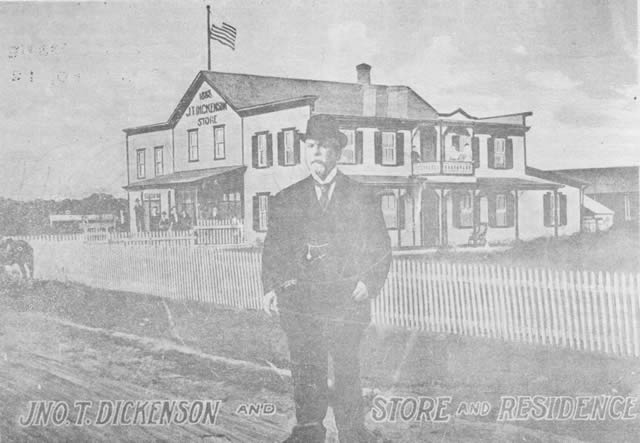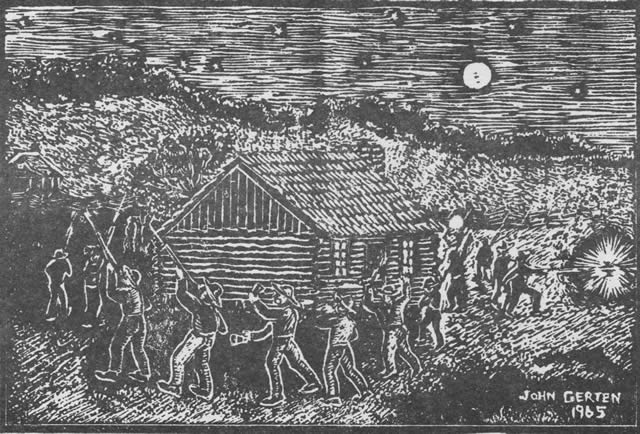Volume 2, Number 12 - Summer/Fall 1967
The Eglinton Colony in Missouri, 1882
by Roy E. Stout

Jno. T. Dickenson and Store and Residence
Twelve English families assembled in New York City, New York, in the year of 1882. Their only purpose was to organize a group of people to migrate westward. Mr. Eglinton was their elected leader in this new venture. Their thoughts and dreams of homes in a new land were all mutual as they would live together and work together for the common interests of the clan.
Preparation was soon made for the trek westward by way of train. They were headed for some unknown destination in Texas or that was their plans. When they arrived at Springfield, Missouri, they learned of the many opportunities awaiting them in Taney County, some fifty miles south of Springfield.
This caused no small stir among the home-seekers, as some wanted to remain in Missouri, and some wanted to continue their journey to Texas. This resulted in eight families going to Texas, and four families going on to the land of promise in Southwest Missouri. The Eglinton family went on to Texas as first planned, but the names of the other seven families still remain missing links in this story.
The four families that came to Taney County in Southwest Missouri, were the Rankins, Dickenson, Sharp, and Miler families. The small colony soon acquired a large tract of land in the Taney City area. Their ambition for livelihood was to raise tobacco and cotton.
Mr. Sharp was elected as the new leader to head the colony; but the colony still carried the original name "Eglinton’, which has caused some misunderstanding about the history of the colony.
The tobacco and cotton venture was short lived, as only two of the families remained in Taney County any length of time. John T. Dickenson remained in Taney County until his death; and Charles N. Rankins and wife lived in Taney County until 1906.
The original plantation house was a three-room log building, with some outbuildings. Mr. Charles Rankins purchased the tract of land where the first colony house was located. Mr. Rankins
[1]
wrecked the old building, and replaced it with a fine new home that is still standing today. At this time John and Bernice (Crouch) and family reside at this location.
ACTIVITIES OF THE COLONY
I have failed to find any records of the Miller and Sharp families after they left Taney County. Mr. Sharp taught school for some time in the Eglinton-Taney City area. It is reported that he then returned to New York City. Mr. Miller also departed from the county. Some think he returned to New York, but there seems to be no proof of this. Could it be that Mr. Miller rejoined the original colony in Texas?
Many older citizens in Taney County seem to think that this is the same Mr. Miller that had one time acquired a large tract of land in the Taneyville or Taney City area. This land was sold in smaller tracts in the twenties; but Mr. Miller was not the owner at that time. This was likely part of the first tract of land acquired by the colony.
John T. Dickenson first sold goods at the old plantation house; and a post office was established at this location. Prior to John T. Dickenson, a Mr. Jacob G. Hulett operated the Eglinton Post Office in 1882. After running the Post Office for six months, Mr. Hulett stepped down for the new Eglinton Post Master, on September, 5, 1882, which was John T. Dickenson. I have no more records on Mr. Hulett and how he fit in the colony.
The old Eglinton Post Office and trading post was the location where Frank and Jubal Taylor flashed a gun, after arguing with John T. Dickenson over a pair of boots. Mrs. Dickenson was shot in the mouth; and later the two Taylor boys were taken from the Forsyth jail and hanged. This incident occurred in 1885.
In the year of 1888 John T. Dickenson built a huge new store building in the south Division of Taney City. This new location was less than a mile south of the Eglinton Post Office. Later there was a post office established at this new location. Mr. Dickenson was very fond of the English writer, Charles Dickens; and that is how the post office acquired its name, Dickens. The Dickens Post Office was discontinued in 1952; but it still goes by the name of Dickens.
Mr. Charles N. Rankins was in very ill health before leaving New York City. The doctor told Emma Rankins that she would be a widow in less than a year unless she could get her husband out of New York City. This was one of the main reasons that the Rankins family joined with the Eglinton Colony. Perhaps the Ozark Mountain climate was just what the doctor ordered for Mr. Rankins, for he regained his health and was able to make a living for his wife and seven children. Mr. Rankins lived to the age of eighty-four years.
Charles N. Rankins was a fine carpenter and a cabinet maker by trade; and some of his craft still remains to be seen in Taney County. When the colony disbanded, Mr. Rankins purchased some two hundred acres where the Plantation House was located. When he moved to Springfield, Missouri, in 1906, he sold the place to Byron Butler.
The four families of the Eglinton Colony were fine solid citizens, which would make any community proud. Before leaving their native England, many of them were affiliated with the Church of England. Their fine pioneer spirit paved the way for greater opportunities in the Ozark region. Their interest in better schools and good churches had its influence in the new land.
Mr. Rankins was a builder and a fine citizen. Mr. John T. Dickenson was a good business man and was active in politics, being a judge in Taney County. Mr. Sharp was an educator, sharing his talent with the hill people. Mr. Miller was a solid citizen and a good business man. This is just a symbol of the many pioneer people that help make the Ozarks what it is today.
DESCENDANTS OF THE COLONY
It would be impossible for me to write the Eglinton story without the information given to me by Mayme Rankins Kirkpatrick of Republic, Missouri, and Alice Dickenson, wife of the late Jack W. Dickenson, who was the son of the late John T. Dickenson. Mayme Rankins Kirkpatrick is the daughter of the late Charles N. Rankins. Both of these women have contributed a great deal to this history of the Eglinton Colony.
Children of Mr. and Mrs. John T. Dickenson, descendants of the Eglinton Colony, are as follows, Sophia, Jim, Jack and Alethea Dickenson. I do not have all the records of their births and deaths; but Alethea Dickenson Morrow died the same year of her father in 1910. John T. Dickensin died on April 5; and on May the 18th, the same year, Alethea also departed this life. Sophia died at an early age, as she was born in 1875 and departed this life in 1890.
Other direct descendants are the children of Charles and Emma Rankins. Their names are as follows: Charlie, Edd, Walter, Edith, Mayme, Anna and Bertha Rankins. This was a fine old family; and some of the children are still living today. Mayme and her husband live a peaceful life in their home near Springfield, Missouri.
Secondary in the lineage of the descendants of the Eglinton Colony are the children of the late Alethea Dickenson Morrow and the children of the late Jack W. Dickenson. Jack Dickenson married Alice Bennett; and Alethea married the late John Morrow.
The names of the Morrow children by this
[2]
union are as follows: Theron, Eunice, Homer and Mildred Morrow. All these children are still living at this date, April 27, 1966.
The names of the children of Jack and Alice Dickenson are as follows: Mabel, John, Clarice, Katherine and Wayne Dickenson. All these children are still living at the time of this writing. Mrs. Alice Dickenson still resides at the old home at Dickens.
Notes on the Dickenson descendants and the old store building: The late Jack W. Dickenson took over his father’s business after his death in 1910. The old building burned to the ground in the year of 1931, and was soon replaced with a smaller building. Wayne Dickenson operated the store for a short while in later years, but soon sold out and moved to Springfield, Missouri.
Chester A. Bennett or better known to his friends as Chub, was the last Postmaster at Dickens, as he was also a brother of Alice Dickenson. The Post Office remained to be operated by some of the family all these years, until it was discontinued.
This brings to a conclusion the story of the Eglinton Colony in Missouri, but perhaps more could be told of the Eglinton Colony in Texas, if we had this information. Some think some of this colony migrated on to New Mexico, but we have no proof of this. We hope that some day all the facts of the migrating Eglinton Colony shall be brought to light.
Some of the Dickensons and Morrows are laid to rest in the Dickens Cemetery, and every year on Memorial Day, people come for miles to pay their respects to these and many more old timers of the long, long ago.
Notes on Other English Settlers
Some historians looking up the record on the Eglinton Colony, have made the mistake of classing other English Settlers with this colony. Following are some names of English Settlers that were not linked with the colony:
Coming to Taney County right before the turn of the 19th century, were the Blakes, Shutes and the Kilby Families. They had no connection with the Eglinton Colony, but played their part well in settling a beautiful new land. These three families settled in the Taney City Area.

"The Charivari" by John Gerten
[3]
This volume: Next Article | Table of Contents | Other Issues
Other Volumes | Keyword Search | White River Valley Quarterly Home | Local History Home
Copyright © White River Valley Historical Quarterly

